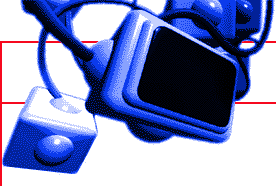EXPLORING MARS
Action-Pak
The aim of this module is to try and explain the thinking behind planning a Mars rover mission.
Approaches
One way of giving insight into the problem, may be to ask your students to imagine they are aliens who have discovered our Earth and ask them what experiments they would design for their rover, to analyse conditions on Earth. For this reason, the beginning of this module concerns itself with local environment observation. Bearing in mind the international nature of this project, the ideas will of necessity be general in nature, but it is hoped that they will be sufficiently practical for use in different areas of the world.
1. Mission Objectives:
- Atmospheric Analysis
- Geophysical Analysis
- Search for Water
- Search for Life
- Capturing Sound
- Pictures
- Sample Return
Younger students, or students in areas which do not have access to appropriate construction materials, might be asked to pretend that they are the rovers, and they have to describe what they see in a given situation, and relay it to a partner who is the "orbiter". They can then apply this insight when designing their rover. Information gained in this way could include avoidance of obstacles, perception of slopes, identifying objects, retrieving objects, clarity of instruction, time delay between giving and receiving instructions. Such a course of action may be valuable whatever the age group, although the older the children are, the more self-conscious they become. Also, some children will be quite happy with abstract reasoning, and not require concrete demonstrations. Individual teachers will know which approach to adopt.
Groups of students can be asked to design specific experiments, and test them in the field. This can then be taken further by the teacher telling the group that only a certain number of experiments can be carried on the rover. From this point, the students have to decide among themselves whether they will sacrifice certain experiments, or whether one experiment can be modified to provide answers for two. Valuable lessons in communication can be gained here. After all, there is no such thing as objective science, and many compromises have to be made along the way in any complex mission. No child's experiment should be "rubbished", and if a child has a good experiment, but is unable to defend it well because of shyness or other factors, then perhpas they can be allowed to call in a firm of "consultants" who can help them prepare their case.
There has to be a physical outcome to the project. This can take the form of a drawing or plan, or can go as far as an actual model, depending on available facilities. The complexity of the final model will vary. One approach to give the students might be to make the event competitive, if this suits the ethos of your school. Imaginary budgets could be set, with individual experiments costing a pre-determined amount, and a rover which meets the largest number of mission objectives for the lowest price would be the overall winner.
Understanding Mars
GOAL: To compare the Earth and Mars as two planets, and use this information to begin designing a rover.
KEY CONCEPTS: To get the students to examine their experiments, and to discuss which ones would be suitable for transferring to the Martian surface: which ones have principles which could survive modification; which ones are of little value. To debate amongst themselves which experiments can be mounted on a rover. To produce small modules which can be mounted on a rover.
OVERVIEW: Mars and Earth are of similar ages, and are made of similar materials. Earth however teems with life, even in the most inhospitable of environments. Indeed, it would seem that when life first appeared, it was in what we would consider to be lethal environments. Mars is smaller than the Earth, and current conditions there would seem to be hostile to life. Yet there is evidence that at some time in the past, Mars was a much friendlier place, with liquid water on its surface. If this is true, then life might have begun on Mars, and may not be extinct, but be underground. The students should end up being able to understand, at least superficially, the things that make Mars different from the Earth, and how to use this knowledge to design suitable experiments.
MATERIALS: Mars fact sheets; illustrations of Mars and the Earth; postcards from different parts of the Earth; globes; posters of the solar system; sand and soil, jars; yeast.
PROCEDURE: Discuss the results of your "alien probe" experiments. Examine the Mars Fact Sheet. Discuss the factors that have contributed to Mars being different from the Earth: distance from the Sun; density; mass; eccentric orbit; thinner atmosphere; constitution of atmosphere; less sunlight; no ozone layer; lower gravity; lots of iron in the red soil. You may enjoy painting your interpretations of Martian landscapes, or of Martian lifeforms. Perhaps you might like to consider what terrestrial lifeforms would end up looking like if they adapted to Martian conditions. Discuss amongst yourselves how these data are going to influence how you develop your Rover experiments. Which ones will you keep and which ones will you reject. will you merge two experiments. Space on the rover will be very limited. You may have to reduce the size of it to fit on your rover. Could you put your experiment into a box no bigger than 10cms x 10cms? Does it stll work? How can you justify keeping your experiment, while not keeping someone else's? How will you support a class mate whose experiment does not make it onto the rover?
Go to Fact-Pak
Go to the Next Page
Click here to return to the Exploring Mars Lessons Index
|





